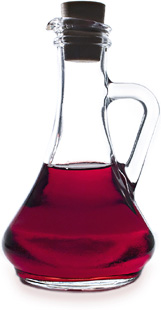 Hi,
Hi,
I have been reading that oxygen turns my wine into vinegar, so when I rack my wine doesn’t the oxygen that goes in to the fermenter hurt my wine?
Thanks Felipe
———-
[Beginner Note: Racking means to transfer a wine or must from one container to the next so as to leave any sediment behind.]
Dear Felipe,
There are two things oxygen can do to a wine. (1) It can oxidize the wine–turning it brown or orange. This is no different than an apple core turning brown. (2) It can also promote the growth of unwanted bacteria and other microbes.
Fortunately, neither one of these are an issue during the fermentation. The release of CO2 gas caused by the fermentation keeps air away from the wine. It also keep oxygen from saturating into the wine.
When the wine is done fermenting, this is when air exposure can be an issue. If the wine is racked in a splashing manor, oxygen can be saturated into the wine, replacing the CO2 gas that was once there. When this happens there is a potential for oxidative, browning effects.
There is also the potential for microbial growth, including acetobacter. This is the bacteria that produces vinegar, or more specifically acetic acid — the tart stuff of vinegar. The air invigorates the bacteria into a frenzied growth, producing more and more of the acetic acid.
Both of these detrimental scenarios can be stopped from occurring with some care and know-how. Here’s a couple of wine making tips to help keep you wine from spoiling.
- When racking the wine use a hose. Don’t pour the wine into the next fermenter. Fill the clean fermenter from the bottom up. This means the hose should reach the bottom of the fermenter and stay in the liquid. This way the wine doesn’t splash.
- Any racking that is performed after the wine brewing has completed, should be followed up with a dose of Sodium Metabisulfite being added to the wine. Sodium Metabisulfite replaces oxygen that may have gotten into the wine with SO2 gas, also known as sulfites. The sodium metabisulfite will also help to destroy any microbes that may have had a chance to call your wine home.
I hope this information helps you out. Just by doing these two simple things you can greatly improve the overall quality of your wines.
Best Wishes,
Customer Service at E. C. Kraus
———————————————————————————————————
Ed Kraus is a 3rd generation home brewer/winemaker and has been an owner of E. C. Kraus since 1999. He has been helping individuals make better wine and beer for over 25 years.

I’m afraid I may have "infected" wine. There is a white layer on the surface of my product. Could this be acetobacter? Should I siphon off the product below this layer into a separate carboy then add sodium metabisulfites? I’m really new at this!
Sandy, you say you are new to winemaking. Are you sure this is not just the wine fermenting. This can be confirmed with a hydrometer. If you know that this is not fermentation, and what you are seeing is a very thin layer, then this could be acetobacter. It is a bacteria of some sort for sure. Regardless, what you said is exactly what you should do. Get the wine away from the visible bacteria by racking from the center of the container into a clean container. Then add sodium metabisulfite to the wine. This will easily destroy any bacteria in the wine.
Would the metabisulfites also kill off any yeast that may be left? If there are still sugars, shouldn’t allow it ferment? Or is it beyond that and it is what it is? Prior to seeing the white "film" the SG was 1.030. I haven’t checked it since then. I will when I transfer.
Sandy, without actually see what you are looking at, I would have to guess that what you are looking at is the result of fermentation activity. If you see the airlock still bubbling you should do nothing until the fermentation is done. You need to get you hydrometer reading down to .998 or less before any determination can be made as what to do next.